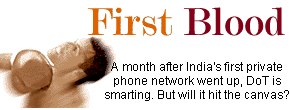


|
|

|
|
| HOME | INFOTECH | HEADLINES | |||
| July 10, 1998 |

A Staff Writer in Bombay
Today, over a month later, DoT's worst fears are coming true. Bharti Telenet had bagged the honour for opening the score for the private sector with its fixed line service in Indore called Airtel.
Now that first blood has been drawn, DoT officials at Indore have hit the panic button. The Indore office has zapped headquarters, pleading for permission to offer discounts to bulk users too. However, the view from Sanchar Bhawan in Delhi, may not be as cataclysmic as in Indore. After all, Airtel has managed only 1,000 subscriptions so far, a tiny fraction of the 100,000 lines that DoT services. "We are putting up a proposal and the Telecom Commission will decide,'' an official at the headquarters has been reported as saying. But it is precisely this complacence which may trip the Goliath that DoT is. Here's an indicator. Besides its 1,000 subscribers, Airtel has another 1,000 subscribers who have registered, claims Bharti Telenet Director Viresh Dayal. Airtel has been offering bulk discounts to subscribers whose usage is above certain benchmarks and who are prompt in paying bills. The discount on the bill value is graded according to usage. Typically, a subscriber would have to bill at least Rs 500 per month to be eligible for the discount, which starts around 2-3 per cent at the lowest eligible slab, going up to 10-12 per cent at the highest slab. The strategy has induced several bulk users to opt for Airtel. Dayal is modest when he points out that most of their commercial connections are new lines and little migration from DoT subscribers has occurred. But DoT is perturbed because, if not users, usage will surely migrate to the private network. The attractive discounts will lead to a situation where DoT lines are used only for incoming calls or for emergencies. DoT tariff structure runs the other way so that the more a subscriber uses a telephone, the higher the tariff! Though the Indore office may be dying to fix matters, can it help itself? Current rules do not permit DoT to offer localised tariffs. The answers to the riddles being mooted in Madhya Pradesh will pose tough questions for DoT all over the country. Tariff fixation is a centralised exercise. Currently, the Telecom Regulatory Authority of India is doing the job. The TRAI's second consultative paper on tariffs is slated for a July-August issue and guidelines for actual tariff fixation may take a few months. There is little hope for DoT unless it manages to sink its differences with TRAI and somehow squeeze out an interim tariff revision. It also desperately needs convince the government that its tariff structures can no longer be the same all over the country. Indore is one story, Kanpur will be another. Today, a 'localised' view to tariff structuring can spell the difference between life and death. Earlier: Tell us what you think of this story |
||
|
HOME |
NEWS |
BUSINESS |
CRICKET |
MOVIES |
CHAT
INFOTECH | TRAVEL | LIFE/STYLE | FREEDOM | FEEDBACK |
|||